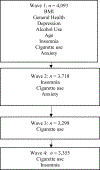Cigarette use, anxiety, and insomnia from adolescence to early adulthood: A longitudinal indirect effects test
- PMID: 33993036
- PMCID: PMC12162129
- DOI: 10.1016/j.addbeh.2021.106981
Cigarette use, anxiety, and insomnia from adolescence to early adulthood: A longitudinal indirect effects test
Abstract
Background: Cigarette use during adolescence has been linked to increased risk for insomnia symptoms, but limited work has examined factors that may account for this association. Adolescent cigarette use and anxiety symptoms characterized by physiological hyperarousal evidence bidirectional associations, as do anxiety symptoms and insomnia symptoms. This suggests that adolescent cigarette use, anxiety symptoms characterized by physiological hyperarousal, and insomnia symptoms may increase and maintain one another. The current study tests physiological hyperarousal anxiety symptoms as a potential indirect effect in the cigarette-insomnia symptoms link across adolescence and young adulthood.
Methods: We examined data from adolescents and young adults from Waves 1, 2, 3 and 4 of the National Longitudinal Study of Adolescent to Adult Health (N = 2,432 with full data). Insomnia symptoms were assessed at baseline (ages 12-16 years), 1 year later (13-17 years), and 14 years after baseline (26 - 30 years) among a nationally representative sample of adolescents. Cigarette use was assessed at baseline, 1 year later, 6 years after baseline, and 14 years after baseline. Anxiety symptoms were assessed at baseline and 1 year later.
Results: Structural equation models indicated that anxiety symptoms exerted an indirect effect on the longitudinal associations between adolescent cigarette use and adult insomnia symptoms. Anxiety symptoms and cigarette use evidenced bidirectional associations during adolescence.
Conclusions: These results suggest that increases in anxiety symptoms characterized by physiological hyperarousal may be one mechanism whereby cigarette use during adolescence is associated with increased insomnia symptoms during early adulthood. Prevention efforts aimed at reducing cigarette use during adolescence may have long term additional benefits for anxiety symptoms and insomnia symptoms.
Keywords: Adolescent; Anxiety; Bidirectional; Cigarette; Insomnia.
Copyright © 2021 Elsevier Ltd. All rights reserved.
Conflict of interest statement
All authors declare that they have no conflicts of interest.
Figures


Similar articles
-
Insomnia mediates the longitudinal relationship between anxiety and depressive symptoms in a nationally representative sample of adolescents.Depress Anxiety. 2018 Jun;35(6):583-591. doi: 10.1002/da.22764. Epub 2018 Apr 26. Depress Anxiety. 2018. PMID: 29697888 Free PMC article.
-
Predictors of early adulthood insomnia following exposure to a single mass violence attack during adolescence: 7-13 year follow-up from the Utøya and HUNT studies.Eur J Psychotraumatol. 2024;15(1):2312750. doi: 10.1080/20008066.2024.2312750. Epub 2024 Feb 22. Eur J Psychotraumatol. 2024. PMID: 38386049 Free PMC article.
-
Longitudinal, bidirectional relationships of insomnia symptoms and musculoskeletal pain across adolescence: the mediating role of mood.Pain. 2022 Feb 1;163(2):287-298. doi: 10.1097/j.pain.0000000000002334. Pain. 2022. PMID: 34001767
-
Mental health antecedents of early midlife insomnia: evidence from a four-decade longitudinal study.Sleep. 2014 Nov 1;37(11):1767-75. doi: 10.5665/sleep.4168. Sleep. 2014. PMID: 25364072 Free PMC article.
-
Gender, depressive symptoms, and daily cigarette use.J Dual Diagn. 2014;10(4):187-96. doi: 10.1080/15504263.2014.961852. J Dual Diagn. 2014. PMID: 25391276 Free PMC article.
References
-
- Baglioni C, Battagliese G, Feige B, Spiegelhalder K, Nissen C, Voderholzer U, Lombardo C, & Riemann D. (2011). Insomnia as a predictor of depression: a meta-analytic evaluation of longitudinal epidemiological studies. Journal of Affective Disorders, 135(1–3), 10–19. 10.1016/j.jad.2011.01.011 - DOI - PubMed
-
- Barrington-Trimis JL., Urman R., Leventhal AM., Gauderman WJ., Cruz TB., Gilreath TD., Howland S., Unger JB., Berhane K., Samet JM., & McConnell R. (2016). E-cigarettes, cigarettes, and the prevalence of adolescent tobacco use. Pediatrics, 138(2), e20153983. 10.1542/peds.2015-3983 - DOI - PMC - PubMed
Publication types
MeSH terms
Grants and funding
LinkOut - more resources
Full Text Sources
Other Literature Sources
Medical

